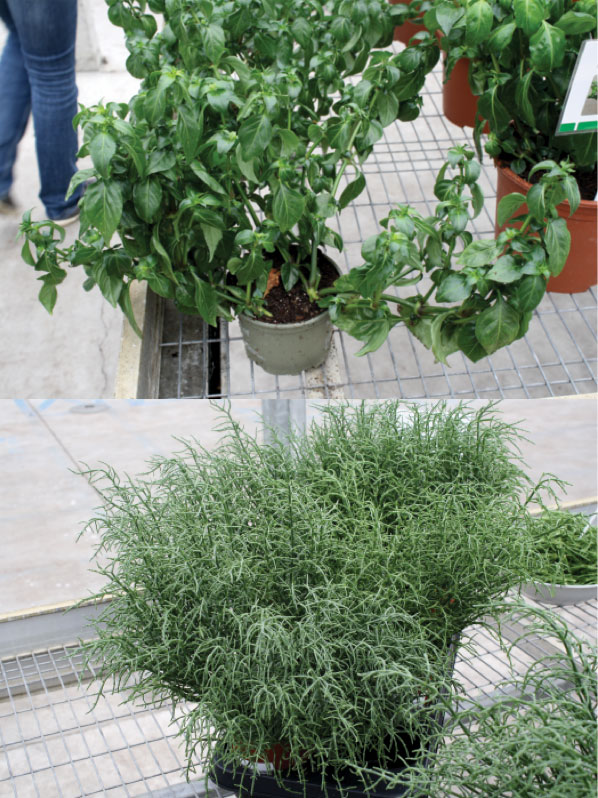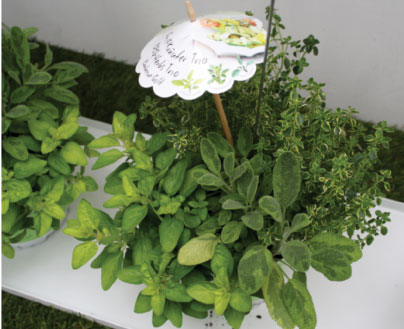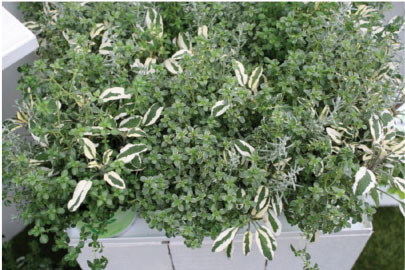6/1/2019
Marketing Containerized Herbs
Christopher J. Currey
One benefit of containerized herbs is that they’re easily marketed in several different ways. Growers can sell herb containers through both retail and wholesale channels: on a bench next to flowering containerized annuals, on a stand next to tomatoes and onions in the produce department of grocery stores, or underneath a tent next to a produce stand at the farmers market.
The fine line containerized herbs ride is between bedding plant, potted indoor plant or ultra-fresh (and then disposed of) cooking ingredient. Whether you’re referring to standard wholesale channels for selling product or to ultra-niche and boutique approaches, this article will highlight a few things to consider for your containerized crops.

Tailor your mix
One daunting aspect to growing culinary herbs is the sheer volume in the number of species that can be grown. There are hundreds (and hundreds!) of herbs, and while you won’t be growing all of them, you can take advantage of this diversity when determining your product mix.
Look at the demographics of your customers (retailers) or your customer’s customers (wholesalers) to see who’s buying your product—it will allow you to make a more saleable product mix. There are certain crops every producer will have to grow, like basil. Then there are the crops that round out your product mix since herb producers have to grow a suite of crops to ultimately support their basil program. But species constituting the remainder of the herb mix is where you can cater to local populations and local flavor preferences. In addition to tailoring your mix, you can take advantage of the broad diversity in herbs and include unique species for a boutique appeal (Figure 1).
Figure 1. Culinary herbs are so diverse, there are many opportunities to diversify with local favorites or niche specialties. The foliage of the mushroom plant (Rungia klossii, top) tastes like mushrooms, while glasswort (Salicornia europea, bottom) has a salty flavor.
Mixed containers
Mixed containers keep increasing each year—both in the number sold by producers, as well as the profit margin for many growers. There can be no doubting the popularity of mixed containers and culinary herbs fit very well into this trend, although edible mixed containers aren’t exactly new.
In addition to a variety of popular herbs planted together, themed containers of different herbs are also great to market. You’ve seen salsa gardens—mixed containers with tomatoes, onion and hot peppers. A similar approach can be taken with herb containers by planting complementary species and marketing the m based on their use. For example, a pizza-themed container has oregano (Origanum vulgare), thyme (Thymus vulgaris) and rosemary (Rosmarinus officinalis) or a barbeque-themed container has oregano, thyme and sage (Salvia officinalis, Figure 2).
m based on their use. For example, a pizza-themed container has oregano (Origanum vulgare), thyme (Thymus vulgaris) and rosemary (Rosmarinus officinalis) or a barbeque-themed container has oregano, thyme and sage (Salvia officinalis, Figure 2).
Figure 2. These mixed containers have oregano (Origanum vulgare), thyme (Thymus vulgaris) and sage (Salvia officinalis), and are marketed together for grilling.
Culinary cocktails
One of the first questions I ask is: “What are the main herb species you grow?” More often than not, the species named right after basil is mint. Over the last several years, mint production has been increasing—no doubt due to the increasing popularity of the Mojito, as mint is a crucial ingredient for muddling with sugar in the bottom of the glass, as well as a garnish on top.
Craft beers have been rampantly increasing in popularity and craft cocktails, whether unique twists on old favorites or new recipes altogether, are starting to have their time. Many containerized herbs species complement this cocktail craze. Why not market your basil for gin basil smashes (gin, sugar, basil and lime)? While many containerized herbs are sold in the produce section of the grocery store, the liquor section may be an effective retail location, too.
Organic
Using organic production methods for growing containerized herbs can be a real benefit to your bottom line. While organic methods for many containerized greenhouse crops aren’t as common as field crop production, it’s arguable that it’s because there’s more interest in using organic production methods for crops that are going to be consumed after purchase.
If you’re interested in growing organically, the major components you’re going to focus on for the switch is what to use and approaches for growing substrate, fertilization and pest control. One of the major benefits for greenhouse containerized herb producers is there isn’t a three-year transition period from conventional to organic, so you can enter this segment more quickly.
Label when you can
Product labelling conveys information to consumers quickly. Are there labels you can use for your product? For example, if you’re growing USDA Certified Organic produce, you’ll want to place that symbol on your product to add value for consumers.
And there are other labels to consider—one trait consistently popular with consumers is the local factor. Whether it’s a sign stating how many miles from the point of purchase the product came from or a sticker denoting it’s a product of a specific state, product origin is of interest to consumers. Depending on where you market your product, local labeling is something you should take advantage of.

The ornamental appeal
Culinary herbs are not only a food crop—they can be highly ornamental (Figure 3). The increased popularity in food has made plants with edible features more popular for landscaping and designing, but they can also be excellent indoor plants as well.
Figure 3. The variegated foliage of these sage (Salvia officinalis) and thyme (Thymus vulgaris) cultivars aren’t only flavorful and useful in the kitchen, they have outstanding ornamental appeal for any coffee table, mixed container or garden bed.
There are some herbs, such as Cardinal Basil (Ocimum basilicum) grown for its flowers and also makes a great cut flower. Try to market interesting cultivars of herbs not only for their culinary use, but also for their ornamental appeal. Don’t limit herbs to being only a food crop.
Containerized culinary herbs are a great greenhouse crop for any time of the year. Whether you already have an established herb program or are looking to start a new product line, there are opportunities to revisit culinary herb production to effectively and efficiently produce these crops for an array of different markets, both well-established and new. GT
Christopher J. Currey (ccurrey@iastate.edu) is an assistant professor in the Department of Horticulture at Iowa State University.